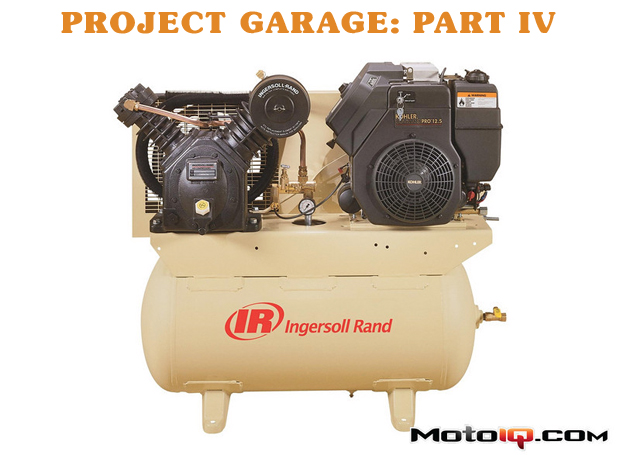,
Now I won’t just let you go out into the world of air compressors without a Cliff Notes guide to what to look for.
Terms to know when choosing an air compressor:
Horsepower
Although there aren’t really any turbocharged or supercharged air compressors on the market, some offer horsepower just short of a 3 cylinder Geo Metro. Ok, not quite… but the hp rating is about just as useful. Unless you’re using your compressor to power you down the street (tried it, not a comfy ride…), pay thismuch attention to hp. Most horsepower numbers are measured on a 220 volt line. Since most homes are typically equipped with only a 110 or 120 volt line in the garage, unless you’re crazy and run your own 220 line like Project Garage, the horsepower numbers are over inflated. The “true” horsepower rating may be less than half the advertised number. Also, electric motors are rated differently. A 5 hp electric motor may be as efficient as a 10 hp gas motor.
Duty Cycle
The duty cycle is the percentage of time a compressor can run. A 50% duty cycle can be used 5 out of 10 minutes. This is typical of smaller, portable air compressors. A good home compressor should have at least a 75% duty cycle. Running an air compressor at greater than its duty cycle will strain the pump and shorten its lifespan.
Air pressure
Air pressure is rated in psi, or pounds per square inch. With the exception of spray guns, most air tools require 90 psi or more. The volume of air a compressor produces is measured in cfm, or cubic feet per minute. CFM will also vary depending on atmospheric pressure, temperature, and humidity. Most air compressors sold in the US actually use a SCFM, or Standard CFM, rating. SCFM is the volume rate of air in standardized conditions. Most air compressors are rated with a standard cfm rating estimated at sea level with a temperature of 68 degrees and 36% humidity. Look for about 3-4 cfm per “true” hp at 90 psi.
Some compressors also include a displacement cfm. This gives an idea of compressor pump efficiency by using cylinder displacement and motor rpm in the equation. Since pumps become less efficient at higher pressures, most compressors come rated with two different cfm numbers, ie. 7.6 cfm @ 40 psi and 5.4 cfm @ 100 psi. You should choose an air compressor that can supply 1 ½ times the maximum pressure required from your air tools.
Tank size
Compressors should be able keep up with what you need them to do. A decent sized tank will store enough air so you don’t have to listen to the compressor constantly running, but a good duty cycle will keep you working no matter the tank size.
 |
| This Porter Cable pancake air compressor is oil free and space conscious. The C2002-WK also includes a 13 piece accessory kit including a 25′ nylon hose, quick coupler and tire chuck and tire gauge. |
Terms to know when operating a compressor:
On/Off Switch
Turns the compressor from off to auto (duh)
Cut in / cutoff pressure
The psi at which the compressor starts and stops to refill the air tank; for example, cut in at 100 psi, cutoff at 135 psi.
Pressure switch
Turns the compressor on when the pressure falls below the cut in pressure or off when it reaches the cut-out pressure
Drain cock
I think I heard Jeremy Clarkson call someone this once on Top Gear. Actually, it releases moisture from the tank. Compressor tanks should be drained of any accumulated moisture after each use.
Safety valve
Exhausts air from the tank if the pressure exceeds the maximum setting by a specified amount
Regulator gauge
Sets tank pressure in psi
Tank gauge
Indicates true tank pressure in psi



